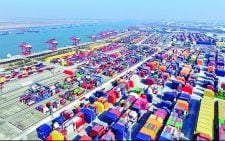Kenya falls behind peers on business incentives

Kenya’s trade attractiveness experienced a slight dip in apprehensions related to fiscal policy changes and social unrest, most notably the anti-Finance Bill protests in June 2024, the latest Stanbic Bank Africa Trade Barometer (SB ATB) says.
This is as Kenya moved from 5th to 6th position, among 10 key African Continent Free Trade Area (AfCFTA) signatory nations, which together account for 66 per cent of Africa’s gross domestic product (GDP).
“Kenya’s decline to 6th place in trade rankings reflects a drop in business perceptions of export growth, access to credit, infrastructure quality, and government support for trade,” the report stated.
Speaking at the launch of the report, Paul Mungai, Head of Trade and Africa China Banking at Stanbic Bank Kenya explained that while Kenya has faced some challenges in trade competitiveness, especially related to inflation and infrastructure, the thriving services sector demonstrates our capacity for growth.
“By addressing key barriers like access to finance and improving trade infrastructure, Kenya can regain its competitive edge and further boost its regional leadership,” Mungai said.
According to the report, variables negatively impacting tradeability attractiveness include Foreign Direct Investment (FDI) net inflows, which have been dwindling over the past three years. In 2023, FDI net inflows were $0.3 billion (Sh38.5 billion), having not rebounded from their fall in 2019. Global FDI inflows had been projected to decline in 2023. This was due to a difficult business environment that prevailed in the year, such as the war in the Middle East and Ukraine, high food and energy prices and high debt levels.
“In addition, tighter international financing conditions affected the availability of credit. These have had a ripple effect on the amount of FDI inflows that flow into Kenya,” the report stated.
Access to credit
Additionally, a gradual increase in Kenya’s lending interest rates on a yearly basis has negatively impacted the country’s trade attractiveness. In 2022, the interest rate was at 12.3 per cent, it then increased to 13.5 per cent the following year.
“Access to credit within the period of the survey proved to be another major challenge for Kenyan business the drop in the index from 49 to 45 signalled tighter credit conditions for Kenyan businesses,” the report said. These higher rates make it difficult for businesses to access the credit they require for investment into their operations as it drives up the cost of borrowing for them.
It also makes it harder for businesses to manage their cash flows effectively, and this ultimately reduces trade activities amongst businesses and business production.
Additionally, higher interest rates also limit consumer spending, as consumers prioritize loan repayments overspending, leaving them with less disposable income for other purchases.
During the period under review, Kenya’s government support index for trade experienced the sharpest decline, dropping from 57 to 45, with surveyed Kenyan businesses signalling a decrease in business sentiment towards government backing of cross-border trade.
“Larger businesses perceived government support more favourably than smaller enterprises, possibly due to their capacity to leverage available resources and navigate complex regulatory landscapes,” the report stated.
It added that despite initiatives to embrace trade agreements and policy reforms aimed at facilitating trade and reducing barriers, the need for tax relief and improved customs efficiency remains a key concern for businesses striving to engage effectively in cross-border trade.















